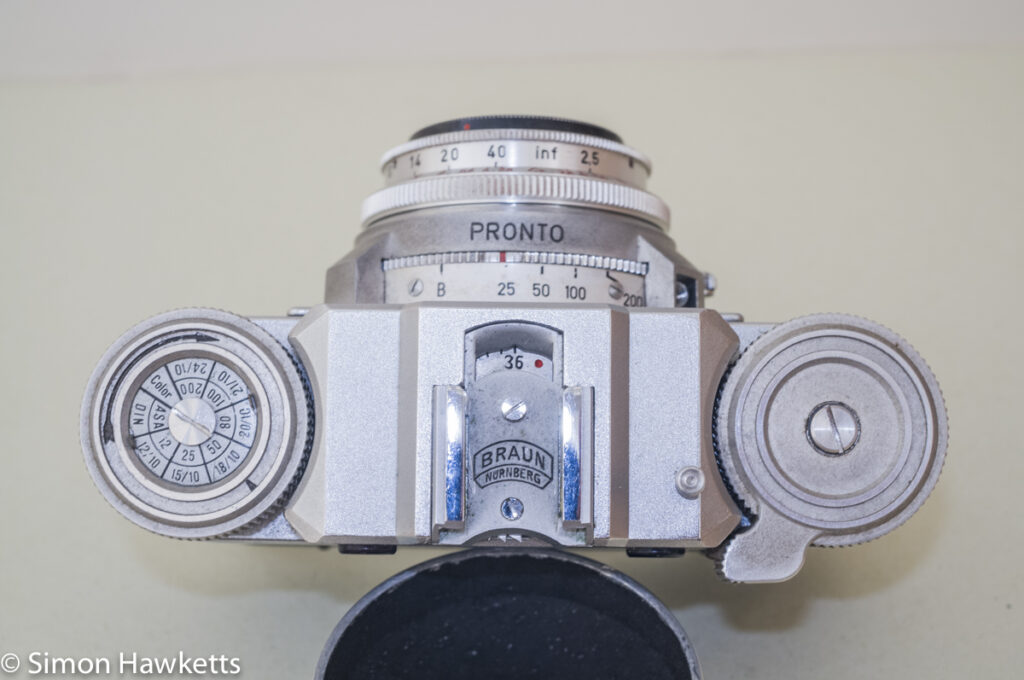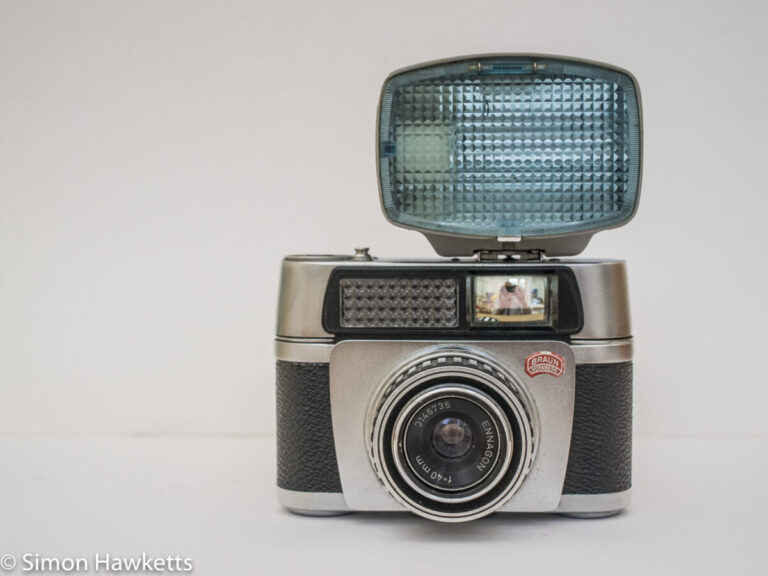Braun Paxette – a novel viewfinder camera from the 1950s
This is a look at the Braun Paxette interchangeable lens, viewfinder camera which was made by Braun of Nuremberg in the early 1950s.
My Braun Paxette camera
I found this camera as an untested auction sale on eBay with a starting price of £0.99 and eventually bought it for about £12 including the postage.
When it arrived a few days after the sale ended, I discovered a clean unit in pretty good condition cosmetically, with a push-on filter and lens hood accompanied by an original leather camera case. Although a bit grubby, there are no serious marks or dents on the camera, although the chrome in the lens barrel is just starting to pucker a bit.
The mechanics of the camera have one small issue, which is that the shutter fires as the film advance is wound. If I engage the self-timer, the shutter cocks properly and fires with what seems like the correct speeds after the self-timer runs down, so I’m pretty sure the problem is some old muck and grease clogging something up in the Pronto shutter.
It looks relatively easy to get to the shutter once the lens is off and the lock ring removed, so my next job will be to investigate this.
One other slight issue was the aperture adjustment, which appeared to be locked solid when I first got the camera, but a bit of use has freed it up nicely over the last couple of weeks.
This is the third Paxette series camera in my collection; the other units are a Super Paxette II reviewed here and a Paxette Electromatic reviewed here.
Pictures of the Braun Paxette Viewfinder camera















Braun Paxette Description
The Paxette is a viewfinder camera with an interchangeable lens mount, which takes screw fit lenses with an M39 thread. Although the very common Leica mount lenses will fit physically, they won’t focus on this camera because the distance from the back of the lens mount to the film plane is different from a Leica (or any of the many Leica clones).

The camera is physically small, almost identical to the Agfa Karat range which were produced at the same time in the early 1950s, although the Karat range of the time were not really in the same class as this Paxette.
Although not unique, it is quite novel for viewfinder cameras to be fitted with interchangeable lenses because the viewfinder will not show the image which will appear on the film. As the focal length changes, the photographer must compensate by trying to compose the image on a central portion of the viewfinder (in the case of a longer focal length), or in the case of a more wide angle lens try to imagine what the picture would look like extended beyond the viewfinder. For this reason, most cameras would be used with an external, separate viewfinder, matched to the lens being used, which would fit into the accessory shoe and be used in place of the built-in viewfinder.
To set the correct exposure, this Braun Paxette is fitted with an extinction exposure meter.
An extinction exposure meter is quite a clever device which allows the photographer to judge the level of light using a second eyepiece on the back of the camera near the film advance.
When you look through this eyepiece, there are three rows of numbers which go from a bright 1 to a dim 12. The idea is that you look through the eyepiece for about 20 seconds until your eye has acclimatised, and then see which is the highest, fully bright number you can make out. This number is the Light Value, and there is a chart in the user’s manual which converts it to a range of f-stop / shutter speed combinations which will be correct for the picture you are taking. At the bottom of the chart is a multiplication factor for different film speeds.
This type of exposure meter was quite common on cameras of the time when there were only a few different films available and most photography was an outdoor, summer hobby. It would become more complex to use when there were many film types and speeds available.

There is an indication of the number of films available at the time by looking at the film type indicator which is built into the top of the rewind crank. There are settings for colour and then 6 different film speeds which can be selected. Presumably, at the time, it would only be possible to buy either colour film of one speed, or black and white film with the limited number of speeds shown on the reminder.
The shutter fitted is a Pronto 4 speed unit, with a self-timer and flash synchronisation. Just above the shutter release, built into the strut of the lens mount, is a threaded hole for a cable release to operate the shutter.
The self-timer has a small lever which acts as a locking mechanism, and which needs to be pulled down before the self-timer can be wound up. This is something I can’t remember ever seeing on any of my other cameras.
The lens supplied is a 45 mm Pointikar lens with an F/2.8 aperture and a focus range of infinity down to just under 2 1/2 ft. Focus is achieved by estimation, or by using an accessory range finder unit.
Loading the camera with film is achieved by removing the bottom section of the case by unscrewing a ring around the tripod bush to unlock it. With the case removed, there is a folding pressure plate which is hinged down and then a 35 mm film canister can be loaded.
With the camera loaded and the pressure plate re-installed, there is a spring on the back of the case which holds it in place when the case is refitted, ensuring the film is held properly in place.
All in all the Braun Paxette is a nice, well engineered, small camera with the advantage of being able to take additional lenses, although as I said above I would rather use an add-on viewfinder for lenses much different from the supplied 45 mm.
Braun Paxette Specifications
- Braun Paxette 35 mm viewfinder interchangeable lens camera
- Small physical size
- Pronto shutter with 1/200, 1/100, 1/50, 1/25 & bulb
- Flash sync socket
- Self-timer with lock
- Manually settable frame counter
- Film type reminder
- Accessory shoe
- Extinction exposure meter
- Cable release socket
- Tripod bush
- Interchangeable M39 mount lenses (but not Leica M39 lenses)
- Fitted with Pontikar 45 mm f/2.8 lens
- Aperture range, f/2.8 to f/16
- Body Serial No: 255277
- Lens Serial No: 542023
- Manual available on-line here.
Discover more from Everything Vintage
Subscribe to get the latest posts sent to your email.




